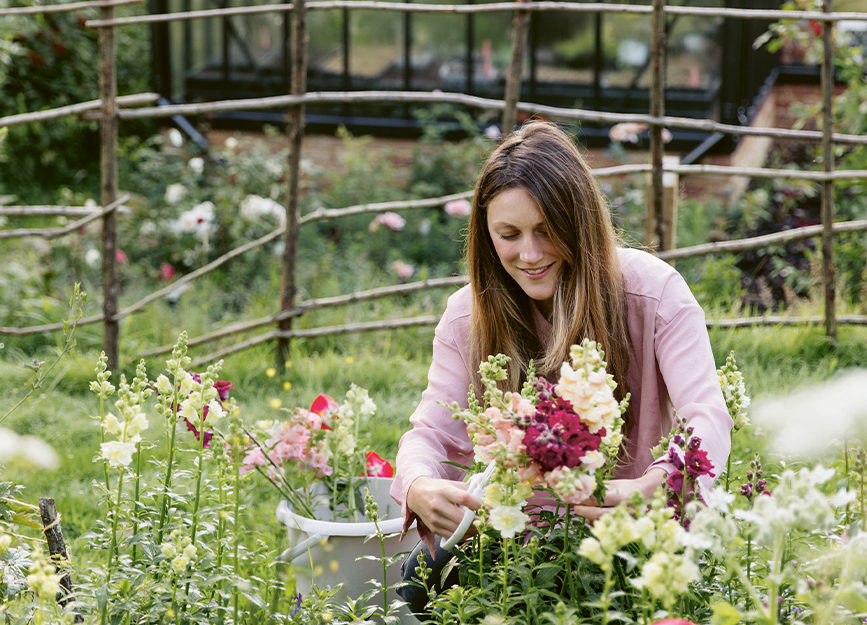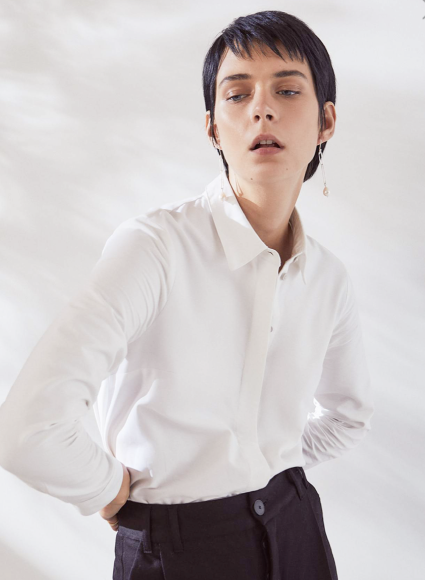
@milliproust
@milliproust


@milliproust
Food & Garden
How To Grow Your Own Flowers Sustainably with Milli Proust
As we continue to examine ways to engage with nature in ways that give back to it whilst helping our own physical and mental health, we are so pleased to welcome a woman who has taught us at REV to be very inspired by sustainable gardening. Milli Proust has just written a book, From Seed to Bloom, which inspires us to all get growing so we wanted to share her wisdom and tips with you.
“For such a seemingly natural product that symbolises and celebrates our connection with nature, most flowers are grown with a huge carbon and water footprint and on top of that, they’re grown and flown a vast quantity of chemicals, pesticides and fungicides.”
Milli Proust
Can you begin by telling us a bit about your personal connection with flowers – how did your creative spirit with the natural world evolve?
A creative connection with the natural world is something, I think, that we all innately have. We all have a creative spirit and it’s easy to forget we are a part of the natural world- we’re not just able to connect with it; we are it. I grew up in London, and a lot of my connection with the natural world was through the plants pushing up through the pavement, the pigeons and city foxes, the shrubs and trees in the local parks, and the wild bits along alleyways and down the railway lines. I spent a lot of my school holidays with my grandmother in her garden, and loved when we could go for long walks through the countryside. It wasn’t until I moved out of London in my late 20’s that I had much more access to nurture and grow that creative connection. Just having the opportunity to be surrounded by a lot more green, and a lot more wildlife has been an absolute privilege and I’ve found it has allowed a creative response to the natural world to flow freely.
Before we get into all the wonderful ways you are growing flowers sustainably, can you first tell us a bit about some of the unsustainable issues with conventional flower growing?
Most flowers purchased from florist shops and the supermarket are simply grown in a way that is harmful to the planet and its people. 80 percent of the flowers bought in the UK are imported and grown in a way that takes more from the natural world than puts back in. For such a seemingly natural product that symbolises and celebrates our connection with nature, most flowers are grown with a huge carbon and water footprint and on top of that, they’re grown and flown a vast quantity of chemicals, pesticides and fungicides.
Can you tell us why seasonality and keeping things local is so important when it comes to flowers?
Seasonality simply embraces and celebrates the rhythm of nature, rather than fights against it at a cost. Whereas buying locally can solve some of the carbon footprint issues, but it’s still vital to do your research on who you’re buying from. Sometimes the thing grown a bit further away may still have a lower carbon and chemical footprint than something grown just around the corner. It’s more important to consider how things are grown and how a business operates.
You also showcase the most beautiful floral arrangements, how do you translate the sustainable ethos of your work into the bouquets you create?
It’s funny, a sustainability ethos doesn’t need to be the driving force in my creative process. I think about it a lot more in the ways that I grow crops and run the infrastructure of my business, but when it comes to designing- I simply create with what I grow, celebrating the ingredients as and when they arrive throughout the seasons.
What does it mean to grow flowers organically?
The way I interpret growing organically is not using any chemicals whatsoever. I ensure that the soil is at its healthiest, I make compost and mulch the soil with it every year. I use the no dig method to limit the damage to the ecosystems and fungi networks in the soil and the infrastructure of the soil. I draw upon companion planting to help plants with pest pressure and plant things in conditions where they will naturally thrive. I add invitations to wildlife in the plot in the way of ponds, hedgerows, grasses and seedheads. I don’t use heat to force my flowers- they’re all field grown, and when it comes to water, I harvest rainwater during our wet winters to irrigate the plot. Thinking about the little things that encourage more life into the plot- that’s how I interpret growing flowers organically.
You talk about regeneration when it comes to how you grow your flowers – can you tell us a bit about how you accomplish that?
It’s less to do with regeneration, there’s already a lot of wildlife here; I’m on the edge of an accent woodland, there’s really no regeneration required where I am. The work I do is more about being sympathetic to what is already here, treading lightly, and putting in more than I take out- be that habitat, forage for bees, or biodiversity for the soil.
You grow on less than an acre and produce the most incredible flowers – how do you produce so much beauty on such a small amount of land?
Soil health is key. Abundance comes when the soil is happy – providing plenty of mycorrhizal networks, food and access to water for the plants. I can usually get two crops each season from each bit of plot through successional planting, and where I grow perennials I underplant with another crop that not only serves me, but will be something that interacts positively with the perennials. For example, salvias seem to do a great job of keeping blackspot away from roses, so the roses are underplanted with salvia.
“Every bit of land is so different, from the soil type, the climate, where the wind comes from and where the sun touches it, that there’s never going to be a perfect textbook to follow when it comes to gardening. This journey of learning the land has felt much more personal than anything else I’ve done, and much more nuanced too- much like getting to know and understand a new friendship.”
When you can’t grow some things yourself, how do you source outside florals that have the same sustainable ethos as yours?
I’m part of a network of small-scale flower growers called Flowers From The Farm. Most small-scale farmers I know have come to growing as their personal contribution to fighting the climate crisis. I’ve made some great friends and working relationships with other small-scale growers who I can rely on for surplus crops when I need.
Do you think the way you grow is scaleable to a larger way of doing things in the floral industry?
Scalability relies on demand and demand relies heavily on trends. Large scale events where the florist or customer wants thousands of white roses in winter are going to prevent sustainably minded growing from scaling up. This includes addressing the desire for any huge quantities of ingredients in the months of seasonal scarcity. If you want floral abundance at a wedding, it’s best to get married in the summer, if you love bare branches and evergreens, winter is for you. The more demand there is for embracing seasonal flowers, the more sustainable it will be for small-scale growers to increase productivity and size.
What inspired you to write a book about your experiences in the garden?
It came from a place of becoming increasingly fascinated by the relationship between the land and the grower- there’s something incredibly intimate about that relationship, and a lot of the books I have voraciously read and loved on cut flowers, floristry and growing were missing some of that intimacy. Every bit of land is so different, from the soil type, the climate, where the wind comes from and where the sun touches it, that there’s never going to be a perfect textbook to follow when it comes to gardening. This journey of learning the land has felt much more personal than anything else I’ve done, and much more nuanced too- much like getting to know and understand a new friendship.
I’ve not been growing flowers for very long- this is only my sixth year growing commercially, and embracing that, I wanted to write in a way that made the practical elements as accessible and easy to understand as possible.I wanted to bring a book into existence that not only was practical, useful, and encouraging if you’re just starting out growing flowers, but celebratory of the personal too- a book that motivates the forming and strengthening of a relationship between a garden and a gardener.
From Seed To Bloom is such an excellent title – can you tell us a bit about what we can learn about sustainable flower goring within the pages?
I walk through everything you’ll need to know to start a garden from scratch, no matter how big or how little your growing space is. It’s packed full of information on how to tend the plants from seed to bloom and back to seed again so the cycle goes on, and I hope I’ve managed to fill the pages with a lot of celebration and inspiration of what it means to grow and harvest in rhythm with the seasons.
How do you find living in the beautiful British countryside affects your connection to nature and slow living?
Growing is a job with really long, unrelenting hours, and working with a perishable crop means you have to work at speed to harvest at the right time and get it into customers’ hands- the only thing that feels slow living about it is how long it takes to grow things from seed. But growing only strengthens the innate connection with nature. I feel very lucky to live where I do now and spend so much time working outside.
Finally, and we know this will be hard question, do you have a favourite flower to grow?
Roses. My middle name is Róża- Polish for Rose, and named after my great-aunt on my dad’s side. My great-great grandmother loved roses enough to call her daughter Rose, and in that thread I imagine I’m tangibly tracing back my family’s love of roses. Great Aunt Róza called me ‘moja mała różyczka’, ‘my little rose’. The last time I saw her, I was 19 and travelled to Poland alone to stay with her for a night or two. It was June and the roses in her garden were just out; a pale rambler climbed up and over the corrugated tin roof of her home. I kissed her hello, and we picked roses from her garden to place in the kitchen, petals falling to the table as we finished off a zupa ziemniaczana (potato soup). When early summer comes, I still think of Great Aunt Róża and her roses, and I love roses all the more for that. It’s my birthday right in the middle of rose season, and for all of this, it easily holds the position of my favourite flower–in the wild, the garden and the vase. Each year for my birthday, many of my friends and family give me a rose to add to my collection, knowing that nothing brings me greater pleasure. There are over 100 now, each with a loved one and a year attached to it, and I’m grateful to the love that is conjured when they’re in flower once again.
Words from Milli Proust @milliproust






























